Quick User's Guide
The User's Guides will provide you with a basic summary of the use of Collect! You can use this guide
to guide yourself through the program or to train new staff members in your organizations. For more
detailed help, please refer to our How to section in
our help.
Working With Collect!
- User's Guide - Orientation
- The User's Guide begins a more in-depth coverage of the software, introducing you to the
user interface and operational details.
- User's Guide - System Administration
- This user's manual is for personnel who will be responsible for configuring your site's
operational preferences and day-to-day systems management.
- User's Guide - Office Administration/Clerical
- This user's manual is topically designed as instruction and reference materials for users
whose job functions are in the areas of support staff, clerical/data entry, accounting
and office management.
- User's Guide - Working Accounts
- This manual is for collectors/tracers, collection managers, auditors, operations/project
managers and all management levels. It provides the fundamentals of debtor screen content
and navigation as well as basics on the subject of working accounts in a WIP list.

User's Guide - Orientation
This user's guide will introduces you to the user interface and some of the details of operating
in Collect!.

Introduction
Collect! is a flexible contact management and financial system designed to be scalable for any
size operation.
It allows you to input clients and debtors with a view to tracking daily financial transactions,
contacts, and other receivable management milestone events. The objective being to provide your
company with an operational environment which maximizes efficiency and productivity, providing
you with real-time metrics to assess the success of your strategies and work flows.

Starting Collect!
If you are running Collect! on a network, please refer to the Help page topic How to Network Collect!
for complete details on how to configure and start Collect!.
Double-click the Collect! shortcut icon on your desktop and the login screen will open.
If you are the first user to enter the system, you can do so utilizing one of the shipping default
logins. We have included a sample sign-on for each user type the system supports to provide you with
a representative sample of what each type of login allows a user to do in the software and what
permissions are inherent in each user level the system offers.
The ID for the 'owner', is a User Level 10, System type of user which has full access to all areas
and features in the software. The ID to use is "OWN" and Password is lowercase "own". You will be
navigated to the Welcome To Collect! screen.
The system ships with 2 different databases for your use:
- The "masterdb" will be your live production environment.
- The "demodb" is a demonstration environment that you can use for both training exercises and later
as a testbed environment where you can test drive any new process, report, letter, import you design
without reservation that you will in any way impact your live production database.
If you have been experimenting with a trial version of the product before now and are ready to begin
creating your live production environment, then Select the Database to open as "masterdb"
If this is your first time viewing the software, you may wish to Select Database as "demodb" as this
database contains sample data which will assist you in becoming familiar with the software.
Once you have selected the database you wish to open, click the Start button to proceed.
The next screen will be the Main Menu if you are a System type user, which the "OWN" ID is. "Collector"
type users are navigated directly to their Work In Progress screens.
Management, Administrative, and Clerical logins have the the Quick Search area on this screen to
search debtors by the most frequently used criteria; File Number, (client) Account Number, Name,
DOB, Phone Number and Email. This screen also positions the user to access all feature menus with
their underlying sub-menus.
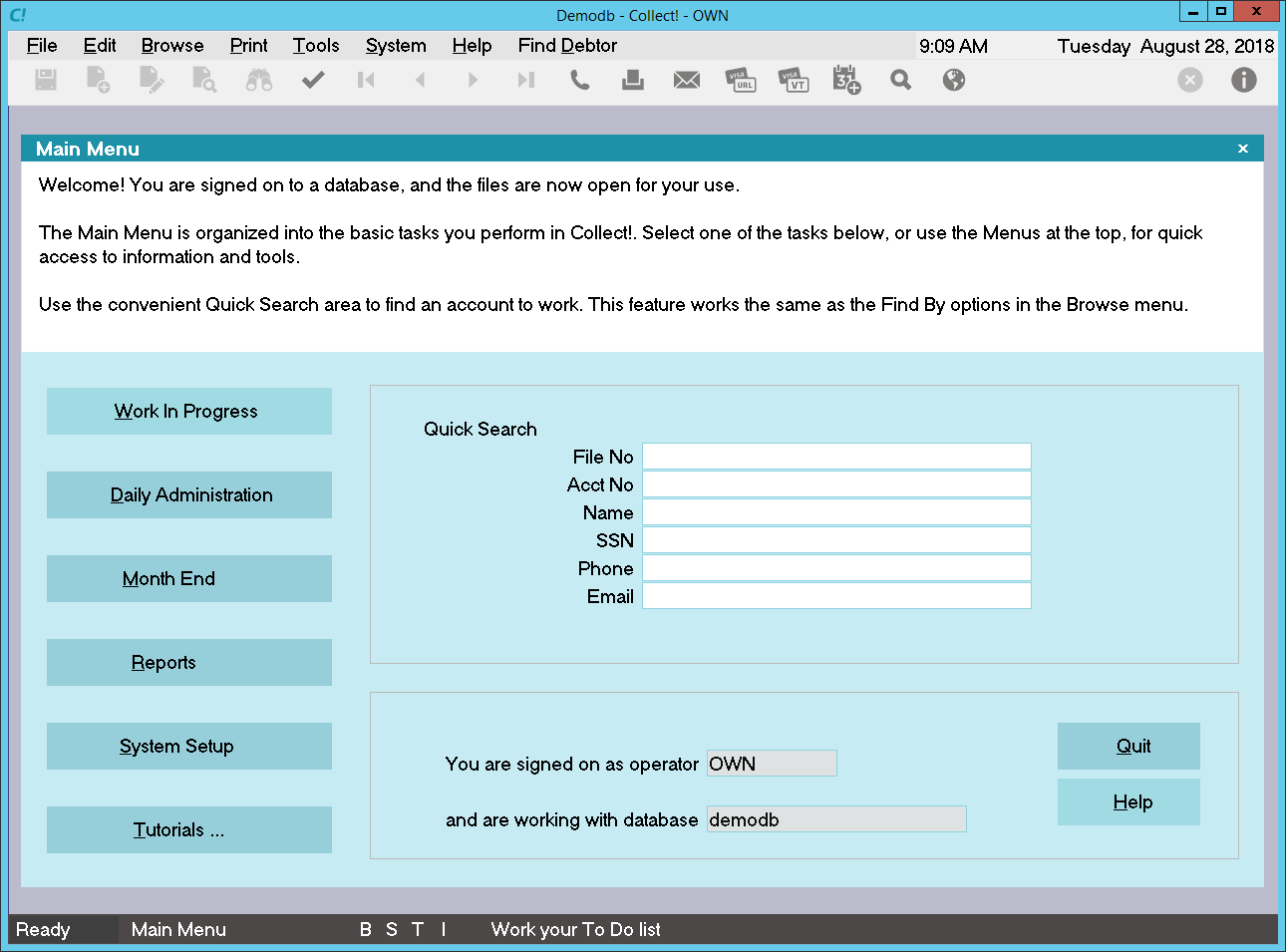
Main Menu

Exiting Collect!
Before proceeding into the use of the system, along with knowing how to correctly enter the system,
it is important to know how to exit correctly to preserve the integrity of your data and database.
One should not power down their computer while a Collect! session is open as this may cause
database corruption.
Always exit gracefully by your preferred exit mode:
- Click the Red X in the upper right corner of any screen and follow the prompts to exit, or
- Press your Escape key to navigate back to the Main Menu and click Quit, or
- Press Alt+F4 for an express exit.

Menus
Collect! uses 3 types of menus.
Full Screen Menus
When you click on a button on the Main Menu or make a selection from a drop-down menu and are
presented with a popup window containing a list of sub-menu items to choose from, this is called
a Full Screen Menu.
The menus are organized to be consolidated by job function of the user who would be most likely
to be accessing these screens.
Example: The Daily Administration button on the Main Menu navigates the user through a series of
sub-menus for daily batch processes such as account grouping, assigning accounts to collectors,
running contact plan automations, letter printing, figure recalculating. System Administration
menus lead to sub-menus pertaining to setups and system configurations which are intended for your
personnel who manage operations/IT Techs. Collectors do not have access to either of these areas.
Click on the menu of interest, then use Arrow keys or mouse clicks to move and navigate between
items. Press the the Enter key or click your mouse to select a presented option.
Top Menu Bar
The Top Menu Bar provides quick access to several specific command functions and sub-menus in the
program.
Toolbar Menu
The Toolbar Menu provides quick access to basic actions like Search, Print, go to First, go to Last,
create a New record, Edit an existing record. If the buttons are grayed out, then they are not active
for the screen you are currently on.

Collect! Help
The system ships with user Help access readily available from anywhere in the system. Context sensitive
Help is available 2 ways:
- Popup windows will present if your mouse is hovering unmoving for a set number of seconds on
a screen or field. The system interprets this pause as the user being unsure of what they want to do
next and offers information about what the mouse pointer is currently hovering over.
- Pressing your F1 key on any field or screen in the system will immediately trigger the opening
of an internet browser on your station and you will be navigated directly to an area in the Help pages
on our website that describes the use/purpose/function of the field of screen you were on when you
pressed F1.
For general access to reference material, your Help Menu drop-down offers the following options:
Takes you to the Help Contents page. This is the equivalent of a table of contents to a full User's
Manual organized in order or operations from initial setups to usage of the system.
Quick User's Guide...
Takes you to this guide.
How To...
Displays a list of all the How To topics.
Keyboard Tips...
Shows you all the Quick Keys to navigate with.
Index...
Displays the Help Index, an alphabetical list of all topics in the Help system. While there is
standard industry terminology, different regions and generations of industry professionals have
their own common names for various aspects of the business. We have tried to insert help terms with
as many synonyms as possible so that no matter what you call it, you can find Help about it in the
Index.
Disable popup help...
Allows you to Disable or Enable the Popup Help feature. You may wish to leave popup help enabled while
you are getting started and disable it when you are acclimated to the system's basics. Disabling the
popup help feature from the Help menu is for the active session only. It will reset to Enable with
your next login. You can turn it off completely from a software switch in your Operator setup screen
discussed elsewhere in the Help pages.
Member Services...
Takes you to the Member Center on our website.
Training Videos...
Takes you to the Training area of the Member Center where you can select tutorials in MP4 video
format.
Report Library...
Takes you to the Member Center Report Library where you can view document samples and download
templates to add to your report libraries.
3rd Party EDI...
Takes you to the Member Center Electronic Data Interchanges area where you can view details and
download working versions of import routines.
Upgrade Software...
Takes you to the Member Center Downloads area where you can review your upgrade or patch update
options, and view the latest new features and revisions lists.
Compares the latest shipping version available online to the version you are running. If there is an
update available, a message will display letting you know this. You can then select the Upgrade
Software option to proceed to the Member Center.
Renew Membership
Takes you to our website where you may renew your membership with all the features and options you
are currently licensed for and purchase additional features. This option is only displayed if you
currently own a license to Collect!.
Order Now
Takes you to our website where you may purchase a license to Collect!. This option is only displayed
if you do not currently own a license to Collect!.
About...
Displays information about the Collect! program. This is useful for your Technicians and our office
to assist you quickly and efficiently by being aware of what version you are currently running.
Printing Help
You may print a Help topic by clicking File, then the Print command from your internet browser when
viewing the Help topic of interest.

User Interface Screens
The software maintains consistent conventions throughout the system to provide you with an intuitive,
user friendly environment. It is designed to accommodate users who favor mouse point-and-click as
well as keyboard control navigation.

Main Menu
The Top Menu Bar
This menu is topmost on your screen and contains a series of drop-down lists containing the commands
or sub-menu options available for selection. A user's level and type determines which of these are
enabled for access or grayed out/inaccessible.
The Toolbar Menu
The Toolbar Menu is displayed at the top of the screen and contains buttons for performing several
basic functions like enter a New entry, fast-path to the First or Last record in a list, Edit an
entry, etc.
A message line is displayed at the very bottom of the screen. In the lower left corner is a word that
identifies what you are currently doing, i.e. Browsing or Editing. Next to the identification of what
you are currently doing, you will see a display of where you are in the system at present, i.e. Debtor,
meaning you are in a debtor screen or debtor lookup list.
Continuing to the right along the Status Bar at the bottom of your screen, you will see a series of
capital letters. These are indicators which become highlighted during various processes. Their
definitions are as follows:
B or E - Browsing mode, means you are in a list. Edit mode means you have selected an item and
can edit if you wish.
M or R - Modified and not yet written to disk. This indicator changes to R for Ready when the
system is waiting for you to choose to do something.
S - Search criteria via clicking Find or F6 has been selected and a search key set is currently
active.
I or O - This indicator shows you whether you are in Insert mode - input will move any existing data
to the right as you type OR Overstrike mode - input will overwrite existing data.
T - Indicator that there is currently an active Tagged list of records.
In the extreme right corner of the the status bar, you will find 2 counter fields. The right-most
corner gives you the total records counted in the list you are viewing or have selected by search
criteria. The sub-counter to the immediate left displays where you are in the current list if you
are scrolling through.
Also in the status bar in the lower right of the screen, you will notice a moving blue bar which is
your indicator of completion whenever any type of process is being run.

Navigation
Your keyboard contains both normal and extended keys used to control the program. These may be used
individually and in combination throughout the system.
Normal Keys
Normal keys include the alphabetic and numeric characters, the punctuation marks and the spacebar.
They are used for data entry but their use can be modified when used in conjunction with the
Extended or Function keys.
Extended Keys
Extended keys are used to navigate within the program and also to exercise control over the program.
They include any of the keys which are not ordinary data entry keys.
Movement Keys
Tab Next field
Shift+Tab Prior field
Right Arrow Move 1 character right
Left Arrow Move 1 character left
Home Go to the start of field
End Go to the end of field
PgUp Next record
PgDn Prior record
Ctrl+PgUp First field
Ctrl+PgDn Last field
Ctrl+Home Go to the start of list
Ctrl+End Go to the end of list
Editing Keys
Enter Save field and go to next
Del Delete cursor character
Backspace Move cursor left, overstriking/removing data
Ins Insert/overstrike
Ctrl+Enter Save and exit
Ctrl+X Cut
Ctrl+C Copy
Ctrl+V Paste
Esc Discard changes
Control Keys
Alt Activate menus
Ctrl Activate buttons
Ctrl+A Select All
Ctrl+F Find. Equivalent to F6
Alt+X Exit the program
Function Keys
F1 Help
F2 Pick from list
F3 Create new record
F4 Edit field
F5 Open form detail
F6 Find record
F7 Delete current record
F8 Save and close
Shift+F1 Record macro
Shift+F2 Play macro
Shift+F3 Paste from the clipboard
Shift+F4 Copy record to clipboard
Shift+F5 Cut record to clipboard
Alt+F4 Exit the program
Alt+F6 Prior record

Functional Details
Buttons
Buttons and icons are available commands. Buttons contain a label and icons present with a
representative image of what the icon is for - phone icon to dial, folder icon to save a document,
printer picture to print a document etc.
Clicking on a button or icon will open a sub-menu, initiate a command, function or process.
Navigating in Lists
Arrow Keys To move up and down in a list and highlight records to be selected.
Enter To Select.
Esc To discard and exit.
Ctrl+PgUp Go to top of the list. Equivalent to clicking First button.
Ctrl+PgDn Go to bottom of the list. Equivalent to clicking Last button.
To Find A Record
From a List, arrow or click into the column header containing the data you wish to search on,
i.e. Debtor Name, and type the name of the person you are looking up. The software will fast-path
you directly to this record if it exists or to the record which most closely matches. The same
method may be used search a list by any criteria column your list contains.
To Add A New Record
There are 3 ways to launch a new entry screen that are consistent throughout the system:
- Click the New button at the bottom of the window, or
- Press Ctrl+N, or
- Press F3.
To Edit a Record in the List
Select a record and press F4.
 WARNING: This is a full Edit mode that will have you making a live change to the record in question
without opening the record. F4 while in a list is a tool for line editing.
WARNING: This is a full Edit mode that will have you making a live change to the record in question
without opening the record. F4 while in a list is a tool for line editing.
To open the record before editing, select the record by highlighting it with your arrow keys or by
scrolling. You can then choose your preference of clicking the Edit button, pressing Enter or clicking
on the record to open it to view. After making your modification, you can then click OK or F8 to
Save and Exit.
To Delete a Record
Select the record you want to delete. You may choose your preference of pressing your F7 or Del keys
or clicking the Delete button at the bottom of the screen. You will be asked to confirm your deletion.
When prompted by the popup message box to confirm, click Yes to proceed with the deletion or No to
cancel the command.
To Copy a Record
Select the record you want to copy. Press Ctrl+C to copy the record to your clipboard and acknowledge
the popup prompt that your item is copied. Then press Ctrl+V to paste it.
If you have reason to place your copy in a different location in the list, first navigate to where
you want the copied item to appear before executing the paste. Your copied record will be inserted
immediately BELOW where you have your highlighted bar situated in the list.
 If you are undertaking a letter/report/import map modification, it is always recommended to
first make a copy of the untouched original template for rollback and/or audit trail.
If you are undertaking a letter/report/import map modification, it is always recommended to
first make a copy of the untouched original template for rollback and/or audit trail.
Alternatively, you can click the Edit drop-down menu from the top of the screen and select the Copy
and Paste options.
To Move a Record
Select the record you want to move. Press Ctrl+X to cut the record, then navigate to where you want
to reposition it and press Ctrl+V to paste it.
Alternatively, you can click the Edit drop-down menu from the top of the screen and select the
Cut and Paste options.
 WARNING: Do not use CUT as a substitute for Delete. This creates records with data and no names,
file numbers or other details associated with them. The records with null fields generated
this way will be problematic on a variety of levels.
WARNING: Do not use CUT as a substitute for Delete. This creates records with data and no names,
file numbers or other details associated with them. The records with null fields generated
this way will be problematic on a variety of levels.

User's Guide - System Administration
This user's guide is for System Administrators. It introduces you to the areas in Collect! where you
can define default operation parameters, setups, create new users, codes of all types, design new
reports/letters and gain access to system level tasks.
The System Administration menu is accessed by clicking the System drop-down from your Top Menu or
clicking the System Administration button on the Main Menu.

System Administration menu
System administration comprises a number of areas.
Setup and Configuration
Use this option to access setup areas for all the feature configuration sub-menus.
Database Maintenance
Use this option to access system maintenance functions.
System setups are necessary before you begin using your system for the first time. By completing
the requisite fill-in screens and decisioning how you want your essential default settings to be
configured, you will start with a clean installation that operates exclusively on your company's
preferences. Not reviewing these options now can result in features seeming not to function to your
satisfaction when in fact, they are performing as per the shipping default settings.
This manual is for executive management who wish to be aware of the functionalities and setting
options which exist as well as the personnel who will be responsible in the organization for
maintaining all feature settings, user logins/securities, and running all maintenance functions.

Setup And Configuration
The System Setup menu shows options for all the setup areas in the system.

System Setup menu
Plans and Reference Tables
Use this option to set up contact plans, transaction types, payment posting automation defaults,
commission rate tables, payment plan defaults, debtor status codes, WIP list default settings and
account matching criteria.

Plans, Tables and Defaults menu
Contact Plans are your automations, i.e. work flows, letter series, inventory
management, account closure routines or any other defined events you have set up to be enacted on
individual or groups of accounts.
Transaction Types is the list of codes that defines the payment types you will use
when posting financial transactions. It is important to note that the system ships with a default
payment breakdown hierarchy of Fees, Interest, Principal, Legal, Misc then Other. If you will use
commission rate tiers and order of operations matters in how payment funds are disbursed amongst the
figure types which comprise your balance, then you will want to ensure that your 100 series
transaction types, excluding 194, 195, 196 and 197 are adjusted accordingly from the shipping
defaults. Codes 194/195 pertain to new Judgment entries and codes 196/197 pertain to new principal
and interest assigned.

The Transaction Type List
 WARNING: Unless there is a specific reason to do so, codes 194 through to 197 inclusive should not
be modified from the shipping default settings. These transaction codes are not meant
to reflect revenue nor are they intended to appear on client transaction detail reporting.
WARNING: Unless there is a specific reason to do so, codes 194 through to 197 inclusive should not
be modified from the shipping default settings. These transaction codes are not meant
to reflect revenue nor are they intended to appear on client transaction detail reporting.
See the Help pages for more detailed information.
The Payment Posting Options menu is where you define any global automations that
are to be invoked on Promise or Payment Plan accounts. It is also where you decision whether you
wish Auto-manage of Promises to take place. If this is checked ON, then data entry of any transaction
will automatically advance promise dates in your Promise Contacts by the schedule defined for that
contact. You may also select contact plans to run, for instance, when an account is paid in full,
or a promised payment is missed. Automatically close accounts, and set other related options.
With auto-managed promise enabled, please be aware that deleting a payment and re-entering it will
do the following:
- With a repeating, in progress promise, Collect! will move the promise date back 1 period when
the payment is deleted, then move it ahead 1 period when the payment is re-posted
- With a completed promise, Collect! will mark the last promise as 'in progress' when the payment
is deleted, then mark it as 'completed' when the payment is re-posted
 If you are deleting and posting payments of different values or values that don't match the
promised amount, we advise that you check the promise contact on the Contacts tab when you
are finished to ensure the promise is set properly.
If you are deleting and posting payments of different values or values that don't match the
promised amount, we advise that you check the promise contact on the Contacts tab when you
are finished to ensure the promise is set properly.
Commission Rate Tables is where you set up any special rate tiers or contingency
types for your clients such as rates by Age of the account in your agency, rates by Listed Amount,
rates by total amount Paid, etc. It is important to set up special rate plans before entering the
client that will need to use said special rate in their Advanced Settings screen. See Help topics
on Commission Rate Plans for more detailed information.
Payment Plan Setup is where you setup the transaction code and contact plan defaults
that your site will use when collectors invoke a Payment Plan from a debtor screen. See the Help
pages on Payment Plans for more in-depth discussion.
Status Codes is the setup and storage of all Status codes that your system shipped
with. If there are any that are unique to your site, you may enter them here. Shipping default codes
may be used, changed or deleted as per your sites needs.

Debtor Status Codes
Contact Plans are the workflow automations you can set up to assist your work plans
and inventory management. The shipping defaults are there for your reference and to serve as examples
of how to make these processes work. You may add, modify, delete these codes as per your site's
preferences.
Contact plans are the vectors you use to insert your dunning letter series, insert telephone events
so that the account will appear in your collector's WIP list with a scheduled work date, set up
Reviews, initiate status changes, automate notes and other activities which need to be scheduled for
specific future dates.

The Contact Plan form
Code
This is a short code for your reference.
Description
This is a brief description of the plan.
Prompt for Start Date
When setting up a contact plan, you may set this option to prompt for a date.
Delete all Pending Contacts
You may set this switch to delete any pending contacts. This commonly used when it is an automated
account closure contact plan.
Prompt Before Deleting
This option will prompt if it is about to delete any pending contacts.
Event
This is a list of events scheduled for this plan. Press F3, Ctrl+N or click New to enter a new event
to the workflow.
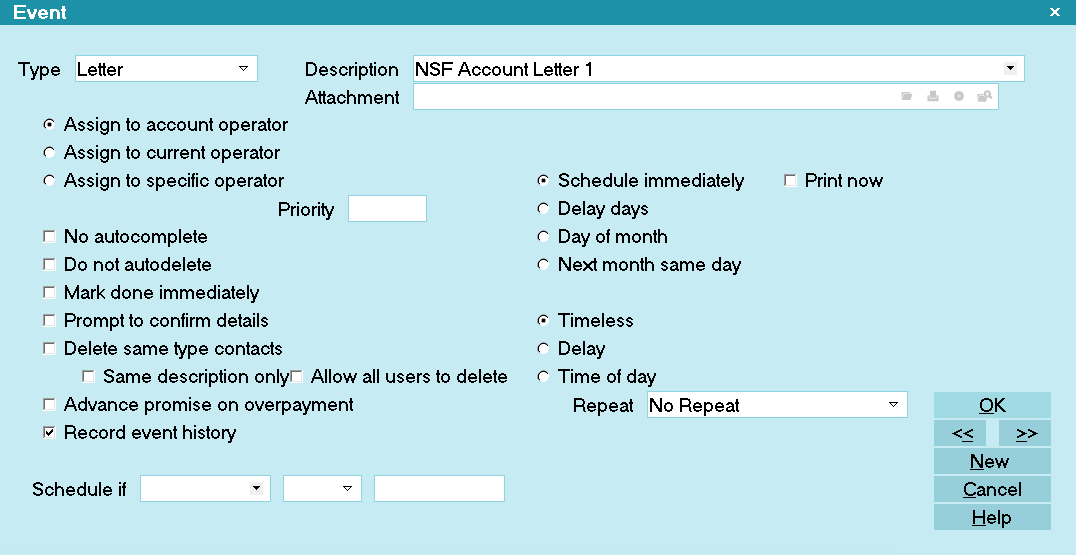
The Event screen
Type
This is the type of event - Letter, Phone, Review or other activity such as modify Status.
Once you select the event type, there will be some which require you to make another selection of
the choices pertaining to that type.
Example: if you select Letter, you must click the drop-down arrow at the end of the Description
field to select the specific letter from the print menu that you want the contact plan to send. If
you select Phone as the event type, you must click the drop-down arrow at the end of the Description
field to select which of the phones the contact is aimed at such as Home, or Work. As this is a user
define pick list, you may add to the choices. Some event types allow a free-form entry in the
Description field, such as Review, Note and Promise.
Delay
You may enter a Delay period between the time and day when you assign a contact schedule and when
the given event is to occur.
For more in-depth Contact Plan details, see the Help pages.
WIP Options are the series of defaults you can set as a global company standard or
for individual collector IDs. These settings will determine what degree of freedom (or not) or
collectors have while working their Work In Progress lists. See the Help pages or press F1 on an
individual switch setting to access more information.
Account Matching Setup are the defaults you will set for your account grouping.
These may be updated and modified as needed. Additionally, if you have a client who has segregation
security requirements, it is also possible to adjust settings for individual new business batches
so that the grouping criteria is correct for that batch, but which is completely different than the
norm applied to other clients. See Help topics on Account Matching for more details.
Company Details
Use this option to enter your company information and default global settings. The company
name/ address/phone fields are required in order for basic reports/letters and statements/invoices
to output correctly.

Company Details
Reports and Printing
Use this option to enter global printing settings, modify existing reports/letters or to create new
templates.

Report and Printer Setup
Security and Aliases
This option navigates you to operator setup, access rights settings, user level setups and password
defaults.

Security and Aliases menu
Database Preferences
This option lets you set global defaults for several system and network settings.
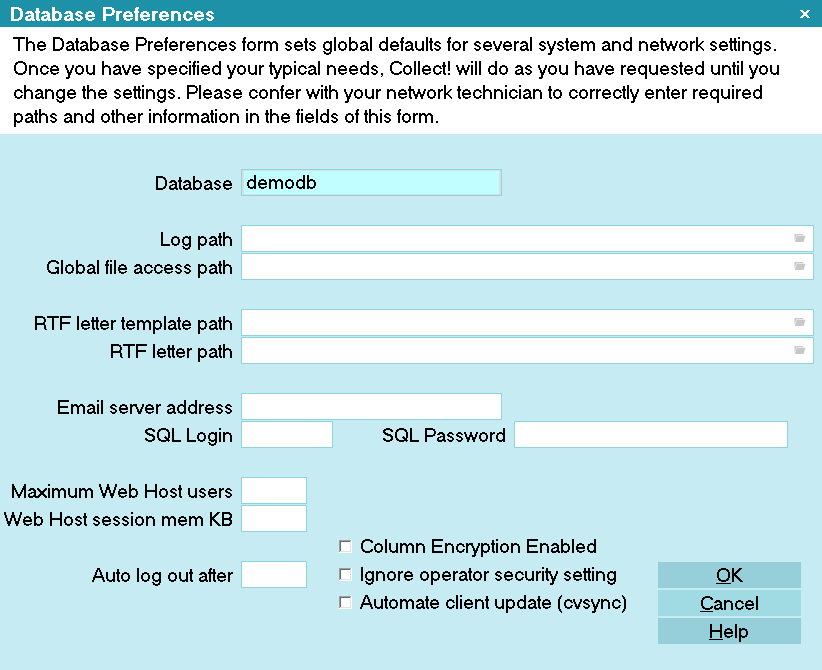
Database Preferences
Credit Bureau Reporting
This option lets you enter details necessary for reporting to credit bureaus.

Credit Bureau Setup
Auto Dialer Setup
This option should not be confused with contact dialer functionality. This feature is a
dial-from-clipboard function which can be configured with your phone system to allow staff to
point/click an icon on debtor or client screens and have their phones automatically dial the number
as it appears in the field. This saves time and the potential for human error in manual mis-dials.
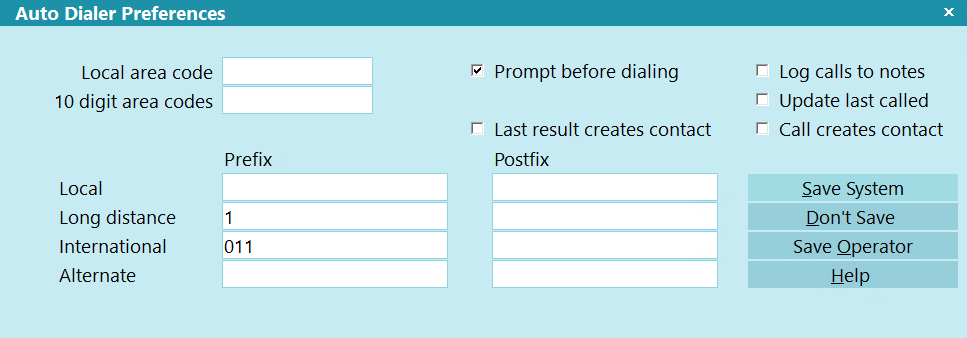
Auto Dialer Preferences
Options, Sounds and Colors
This option allows you to set a variety of software switches that affect individual site preferences
and pertain to defaults affecting global operating of the software.
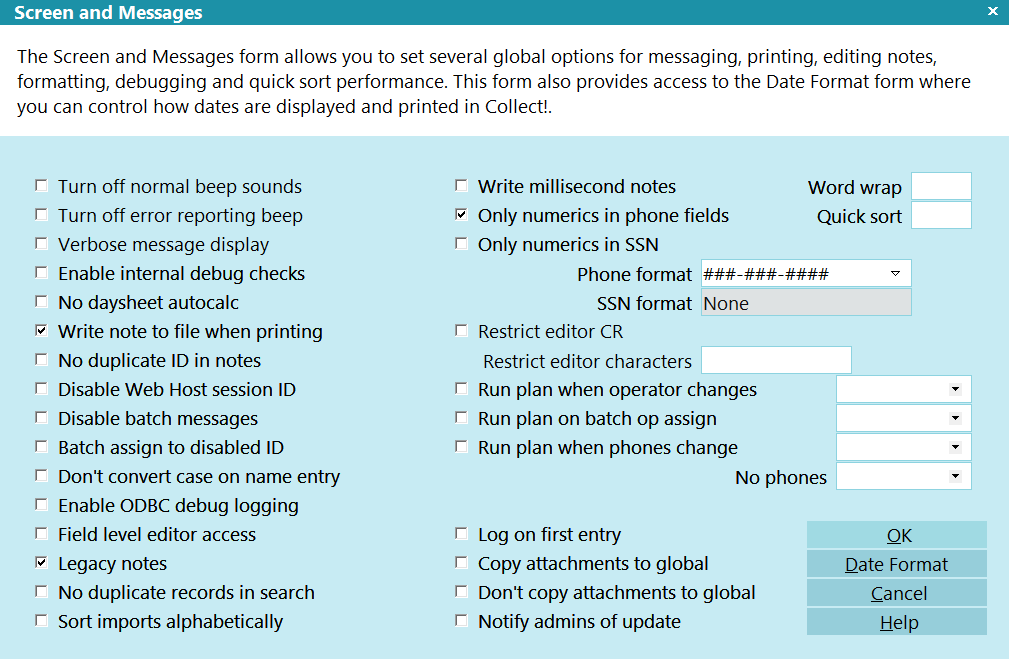
Screen and Messages

Tools Menu
The Tools menu may most often be accessed by office administrators and system administrators.
Depending on the size of the agency, one department may be responsible for both sets of job tasks
and thus, the Tools menu was created to contain the items a blended department may require for their
day-to-day operations.
RECALCULATE
This option navigates you to the Recalculate Totals menu where you may choose to update debtors,
clients, and daysheets.
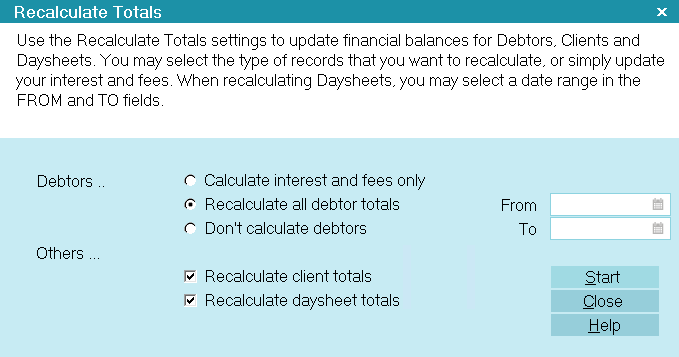
Recalculate Totals
Calculate Interest and Fees
This function scans through all debtors and processes those with interest switched on. Interest is
calculated for all debtors with an interest rate and an interest calculation Start Date defined.
The default is leaving this unchecked as the next option, Recalculate All Debtor Totals has
replaced it.
Recalculate All Debtor Totals
This function will recalculate all debtor balances for accounts with an Active mode. Closed accounts
are not recalculated.
Recalculate Client Totals
This function will recalculate accounting totals for all clients.
Recalculate Daysheet Totals
This function will recalculate all daysheet totals or a selected date range of daysheets.
Recalculating daysheets updates the totals calculated for each date. The system maximum for daysheet
recalculation is 2 years.
Sort Accounts
Debtors are automatically sorted in the Browse lists, but not in the Client lists or on Statements.
The Tools menu, Sort Accounts option enables you to set the sort option in the Client Settings to
Debtor Name or Client Account Number.
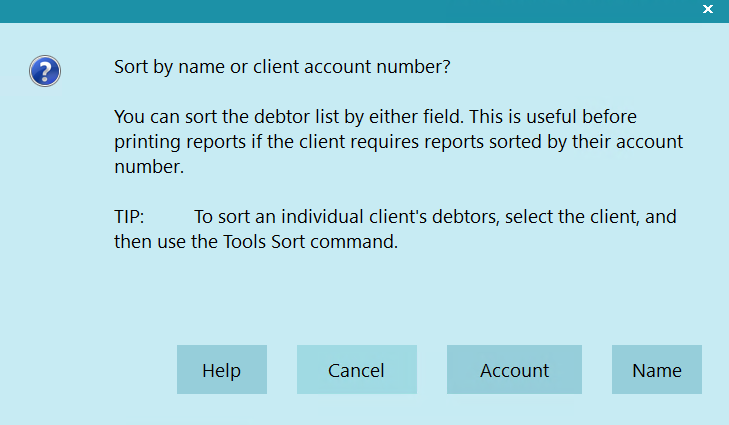
Sort Accounts
 If the sort order on a Client is not set, then the accounts will be displayed in the order
that they were created.
If the sort order on a Client is not set, then the accounts will be displayed in the order
that they were created.
Account sorts by the debtor's client account number.
Name sorts by the debtor's Name.
SCHEDULER
This is an add-on module which requires separate licensing. See Help pages for in-depth reference
and usage instruction.
UTILITIES
The Tools, Utilities sub-menu will be a resource for needed tools from time to time, but does not
contain anything necessary for initial setup. See Help pages on Utilities for more in-depth information.

System Menu
The System menu is access to many of the same features as discussed above from the
System Administration menu button. Discussed in this section will be those options not offered from
the Systems Administration button, that are necessary to review for initial configuration settings.

System Menu
Change Password
This option displays the Change Your Password popup window where the operator who is signed in may
enter a new password to use the next time they login.
Company Details
This options was discussed previously and is required entry material for reports/letters as well as
statements/invoices and checks to output correctly.
Rights
This option will pass you to side of sub-menus where you may enter user, user level and access
rights/permissions setups.
See How To Setup Operators in the Help pages for in-depth discussion.
Layout and Languages
This option will pass you to side of sub-menus that access permissions you wish operator levels to
have in specific fields and screens throughout the system.
The more direct method to altering user level permissions for fields and screens is to right-click
your mouse on the area of interest that you wish to modify user permissions on. This will open the
Access Rights screen specifically for that area and eliminate the need to scroll through a long list
of field and form level entries. Excepting where permissions are being increased or decreased within
a full menu of items, most needs will be met by the right-click method. If you do not achieve the
desired result, it is possible that multiple fields require modification to achieve the singular
result. Consult the Help pages or contact Tech Support for advice.
Financial Settings
This option was discussed previously and takes you to setup areas for Transaction Types,
Payment Posting, Commission Rate Plans, Payment Plans, and Credit Bureau setups.
Contact Management Settings
This option was discussed previously and takes you to setup areas for Status Codes, Contact Plans,
Work In Progress, Account Matching, and Auto Dialer setups.
Network and Environment
This option takes you to Network, Archiving and Database Change Logging configuration, Web Host
Security settings and Messaging.
The side sub-menus have uses for systems administrators. If you are getting messages that there
are users being refused logins because there are not enough licenses but you know you have enough
licenses to cover all your users, you can verify whether some users may have multiple sessions open
by clicking Active Users. This will display a window showing all current sessions open insofar as
the Collect! Server is concerned. If you see multiple sessions for any users, you can ask them to
logout of the extra sessions they have open to free up user login license space. You also have the
ability to prevent users from having multiple logins at the Operator setup level. See Operator topics
in the Help pages for details.
Diagnostics
This option will primarily be used when you need to view the Application Log or the Credit Bureau Log.
These are not necessary for the initial setup of your system. See the Help pages on the log topics
for more details for later usage in areas of tracking and troubleshooting.
Software License
This option displays the details of your license.
Send Database via FTP
This option enables you to send database files to Collect! for technical support.
Preferences
This option opens the System Setup sub-menu, all options of which were discussed previously.

System Security
Collect! has multi-tiered security features which allow you to control both the access and degree
of access your users will be granted within the system.
The permissions hierarchy is determined by:
- Operator Type
- Operator Security Switches
- User Level
- Access Rights on Menus, Forms and individual Fields
The software ships with a series of pre-set logins which are configured with default settings as
examples of what each general type permits. These logins match general duties such as junior or
senior collector, data entry, office manager, etc. You may modify permissions on the default Levels
to meet your individual site needs OR, as we recommend, make copies of the defaults and THEN modify.
This latter allows you to retain a working exemplar of the default settings in case needed at a
later date.
To access user setup menus, select System from the top menu bar and then select Rights from the
drop-down choices.
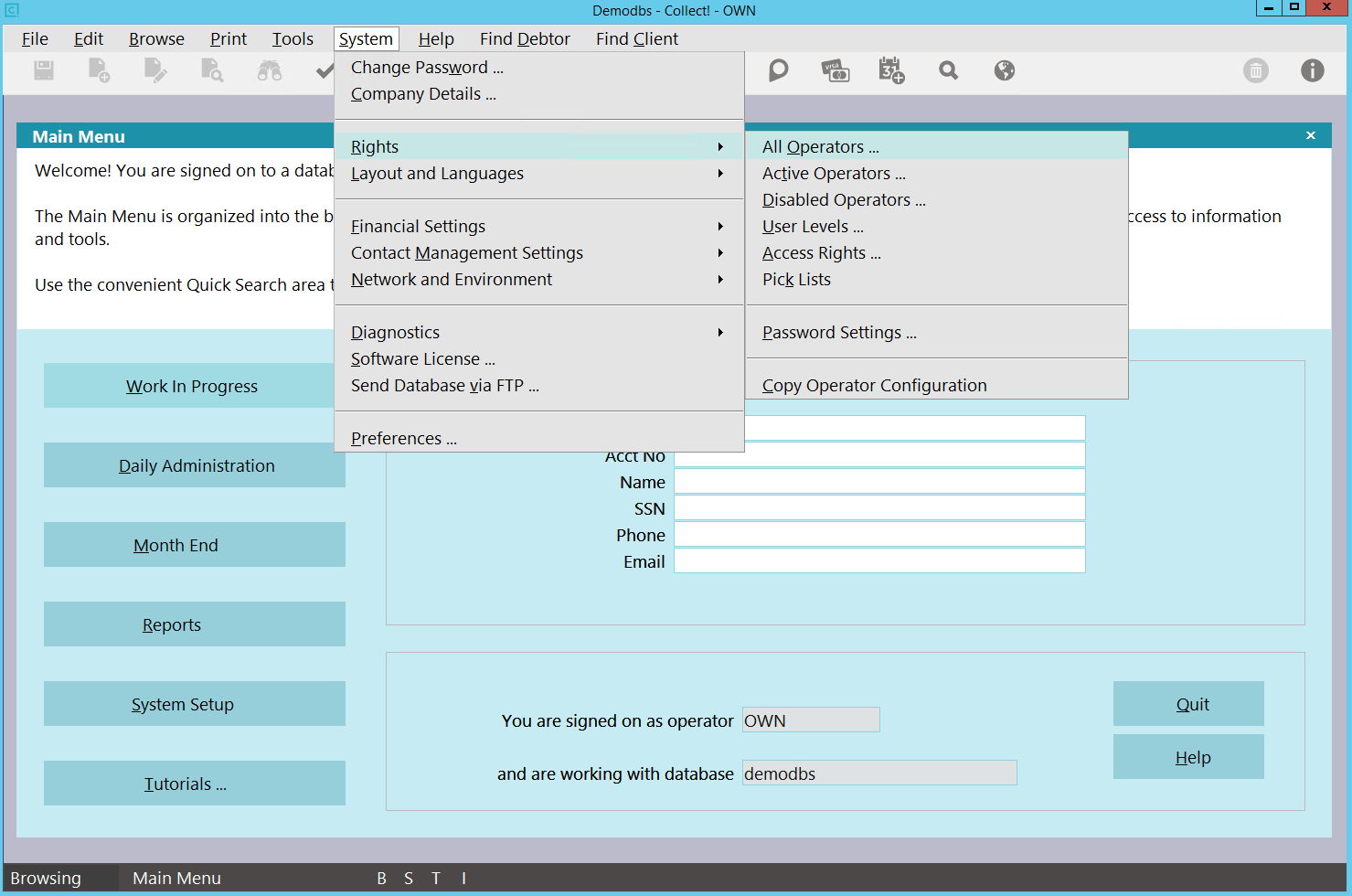
The System Menu - Rights
Operators
This option lets you create and edit logins. It is where you select your user Type which predicates
menu access, enter user ID/name and other internal contact details, assign special security controls
such as account or portfolio restriction, password controls, team membership, session permissions
and experience level.
User Levels
This option ascribes a set of user permissions which dictates what menu combinations a user will be
granted access to. Each User Level contains pre-configured settings that are by design intended to
allow general permissions relative to job duties. You are able to expand or tighten the permission
degrees to suit your individual site preferences. Permissions on menus, forms and fields are in the
4 categories of Full, No Delete, Read Only, or No Access.
Access Rights
This option lists all forms and menus in the system. It shows which user levels are allowed to
access them and what the current degree of access is; Full, No Delete, Read Only or No Access.
Password Settings
This setup screen allows you to stipulate Password standards for number of characters, numeric/special
character requirements, lock-out after "X" failed attempts and renewal frequencies. If your site
does not require tight security to meet internal or client directives, these settings do not need
to be defined.
The links below provide detailed instruction on setting up Operators, User Levels and customizing
Access Rights.

Account Matching And Grouping
Accounts can be grouped together automatically and manually, and can optionally share information
so that when you make a change in one account the change also appears in other accounts in the group.
It is recommended to review the shipping defaults and make any changes that are necessary to
accommodate your individual site's needs.
The Matching Account setup screen is located on the menu path "System\Preferences\Plans and Reference
Tables\ Account Matching Setup".

Matching Accounts
When you are on any member of a group, you have instant access to other members of the group, plus
a summary of all accounts in the group.

Account Matching Setup

Account Matching Setup
| Turn on this switch |
To enable this function |
| Enable account matching |
This is a master control to turn on and off the
automatic account matching functions when entering new
debtors. |
| Prompt before copying |
Adds an extra prompt before cascading changes
across to other group members after you've made changes to
a debtor within a group. |
| Check and prompt on close matches |
When you enter data into a checked field,
Collect! searches the database for a matching record or a
close match. You can choose from the matching list to group
the new and old records together. |
| Copy when creating new debtors |
When you group debtors, you can control which
fields are copied from the existing debtor to the new debtor.
Check the fields that you want copied. This setting requires
consideration and caution. Once enabled, it will overwrite
data fields on other accounts potentially preventing more
current information from being introduced since existing data
may be invalid and new, incoming data may be more current. |
| Cascade data to other group members |
When you make a change to selected information
on a debtor that is a member of a group, you can have the
system automatically update other members of the group. Check
the fields that you want to be automatically updated. |

Designing Letters And Reports
You can design your own reports and letters to print from Collect! in addition to modifying external
reports that ship with the software or which have been downloaded from the Member Center.

To Edit Reports And Letters
- Click the Print drop-down menu from the top of your screen.
- Select Customize Printing, then Edit Report Templates.
- Select the report or letter which you wish to edit and click on it to open it, OR click New to
open a fresh report template to be designed. Your F3 key can be used as a quick key to create a
new template.

Selecting A Report
Reports can print any database information co-mingled with static text and graphics. You can also
choose font types and size to output in your created documents.
 For best results, consult the Help documentation for detailed assistance with Report Writer
Topics.
For best results, consult the Help documentation for detailed assistance with Report Writer
Topics.
To add a field code, date, page break or formatting code, place your cursor where you want the item
to display or occur and press F2. Key in the parameter you wish to place or select a printable
field code from the list pop-up you receive after pressing F2.

Flexible Queries
If you need to create an ad hoc report and wish to manipulate the data yourself in a spreadsheet
environment, you can Browse any of the record types stored, use the Find feature to include or
exclude records based specific criteria then Quick Print to results out to spreadsheet. For example,
Collect! will display all debtors with a given status or all contacts on a certain date or, it will
list all clients with less than 10 accounts, and whose listings total less that $10,000. Once you
have entered your selection criteria and reduced the list, you can print reports on just the
selected records.
Here is an example:
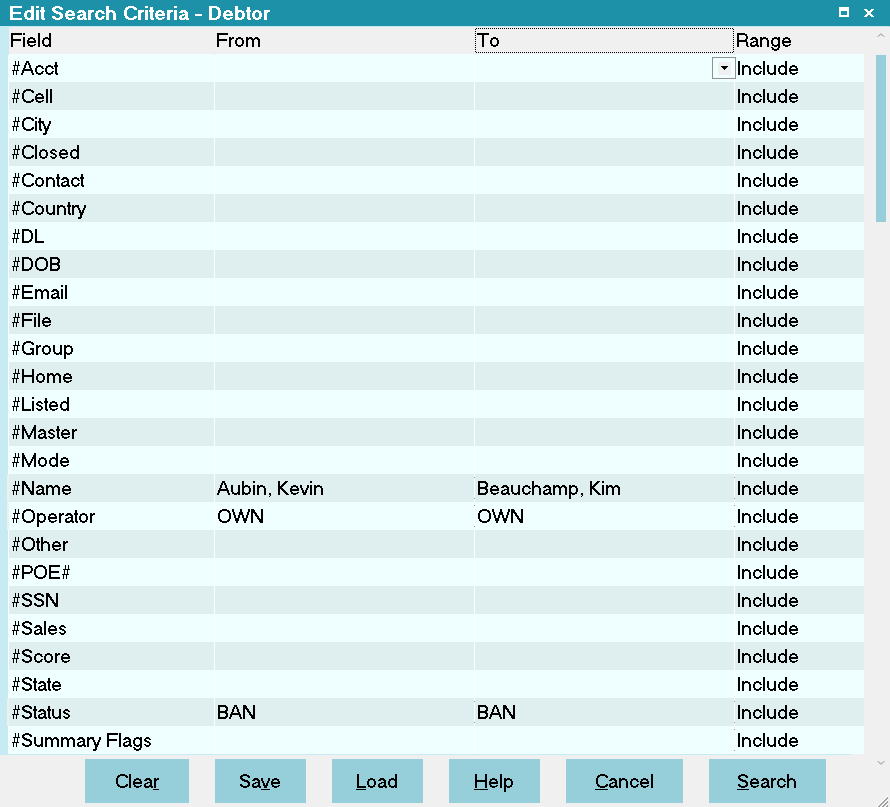
Edit Search Criteria Query Screen

Adding Or Changing Pick Lists
Pick lists give you a list of choices to pick from when you enter data into a field. When you pick
an item in the list, it is entered into the system as if you had typed it. You can assign pick lists
to virtually any field on any main screen.

To Add Or Change A Pick List
- Click the field you want to edit.
- Choose Field Properties in the System, Layout and Languages menu.
- Double-click the Pick List File field in the displayed form and follow the instructions displayed
on your screen.

Editing A Pick List
 To get even more flexibility from your pick lists, add a blank item that you can type
information into. In the list add the item " " at the bottom of the list. There must be a
space between the quotation marks.
To get even more flexibility from your pick lists, add a blank item that you can type
information into. In the list add the item " " at the bottom of the list. There must be a
space between the quotation marks.

Changing Field Labels
If you wish to rename a field on a debtor or client screen to reflect what is most meaningful for
your site, this may be accomplished by renaming it with an Alias field label. For example, if you
want to rename the debtor screen User 1 field to be OrigCred to stand for Original Creditor, the
steps are as follows:

To Change Field Labels
- Mouse into the field you want to edit and right click.
- You will get a pop-up window with one option being Properties. Click Properties to open the
Access Rights pop-up.
- In the upper right corner beneath the actual field name, is a field called Alias. Input the new
field label you want to have displayed on screen in the Alias field, then click the OK button to
save your change.
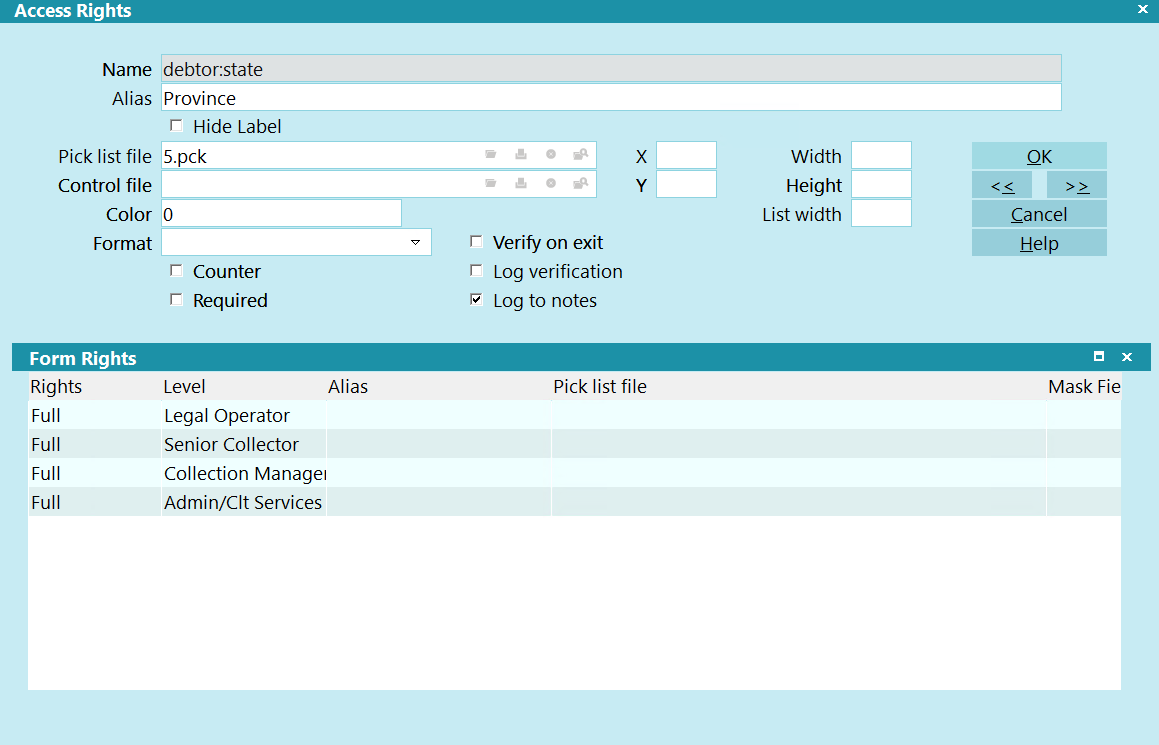
Changing A Field Label
 A relabeled field retains its original field name and printable field code when being called
upon in the body of a report or letter. For example, if you wish to have the User 1 field
from the debtor screen be expressed in a letter after you renamed it to be OrigCred, you
would still use the code @de.u1 to get output in your letter.
A relabeled field retains its original field name and printable field code when being called
upon in the body of a report or letter. For example, if you wish to have the User 1 field
from the debtor screen be expressed in a letter after you renamed it to be OrigCred, you
would still use the code @de.u1 to get output in your letter.

User's Guide - Office Administration/Clerical
This is a reference guide for administrative staff.

Main Menu
After signing into Collect!, you will navigated to the Main Menu.

Main Menu
This screen shows you the areas of access. You have Search fields in the lower right corner, Menu
buttons on the left and Drop-down Menus across the top of the screen. The reason why there is some
overlap in navigation paths through the system is because it allows different user levels unique
paths to areas they are permitted to access as well as accommodate users who favor one access path
over another.
The following is a brief description of the visible options offered on the Main Menu.
QUICK SEARCH is 6 lookup fields where you can search for debtor accounts by the most common look
ups; file number, (client) account number, name, DOB, phone and email. The Name search will also
look for any cosigner or associated party names which you may store in Cosigner windows of any Class
description.
WORK IN PROGRESS navigates you to the WIP lists in the system. For non-collection personnel, this
is the access point for all WIP lists. Reloading and selecting the Operator ID of choice will
display that ID's working accounts and desk counts.
DAILY ADMINISTRATION navigates you to all data entry and batch processing.
MONTH END navigates you through the options to generate client remittance statements/invoices and
checks, and associated summary reports.
SYSTEM ADMINISTRATION accesses system configuration and database maintenance menus.
REPORTS provides access to all reports - those internal to the Collect! program (hard-coded) as well
as your company's library of external and custom reports/letters. The source code for external
reports and custom letters/reports is contained in the document body of each, as stored in your
Report library.
TUTORIALS takes you to our website for a demonstration of basic functions and features.
QUIT exits the database.
The following are brief descriptions of feature usage. For detailed instructions, see the link(s)
trailing each topic.

Daily Administration
Click the Daily Administration menu button to access the sub-menus.

Daily Administration Menu
PAYMENTS AND CHARGES takes you to a transaction entry area where you can apply payments/charges to
debtor accounts and post payments from clients.
These tasks may also be performed directly from a debtor or client screen.
DAILY BATCH PROCESSES is the sub-menu set from where you may print letters, perform batch functions
such as account grouping or assign accounts to collector desks, or recalculate all financial totals
in the database for debtors/clients/daysheets.
NEW BUSINESS is where you can enter new Client and Debtor records.
These tasks may also be performed directly from a Browse Debtor or Browse Client list. Additionally,
you can enter new debtors from within the Client that the new accounts belong to. This saves
keystrokes by auto-populating the client number and client name as you enter new debtors.
BROWSE DAYSHEETS lets you view summary information stored in Collect! that reflects the day's
accomplishments on a per calendar day basis.
EXIT returns you to the Main Menu.

Introduction To Reports
Printing for daily and monthly activities is typically done using the options displayed in the menus.
There are 3 types of reports available in the system:
- Internal Reports - This category defines reports which are hard-coded in the
software itself and the source code is not available for modification. These are selected by
name from a system menu other than the Print Menu list of reports/letters and are launched
directly from that source. Examples are: Daily Cash Report, Month End Payables and
Receivables, Month Batch Analysis
- External Reports - These are documents for which the report code is stored
in the Print Menu list and these are possible to modify for individual site needs. They are
launched by clicking into the Print menu and selecting by name from the available
reports/letters stored in your print library of documents. Examples are: letters, statements,
activity, commission and transaction summaries
- Quick Print Reports - These are the equivalent of ad hoc queries where you
may select the data set by first Browsing into a list of the items interest (i.e. Debtors,
Clients, Transactions) and tagging them as a list. Requesting a Quick Print of these records
with All details or abbreviated output allows you to export data into a csv spreadsheet where
you may perform data manipulations to meet your office's needs. Examples are: a listing of
all postings within a prescribed date range that were applied with a specific Transaction Type
(i.e. Court Costs or Fees), create a list of debtors with specific balance and list date range
with a particular status code

Print Menu
The Print menu provides access to all the reporting functions in the system.
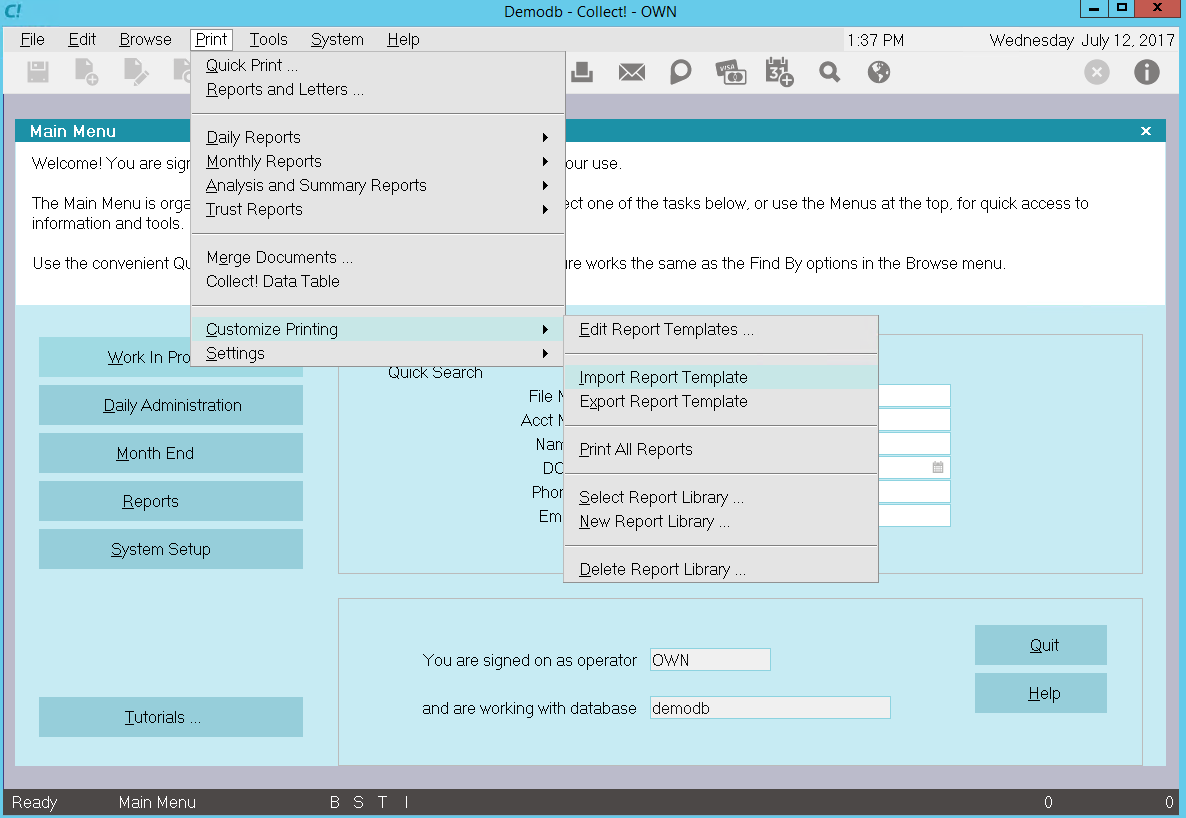
Print Menu
QUICK PRINT
Quick Print will output All or abbreviated data pertaining to an individual screen or list of records
currently displayed on your screen.
REPORTS AND LETTERS
This option accesses modifiable reports and letters stored in in your print library.
DAILY REPORTS
This option navigates you to a list of frequently used, standard internal reports and tasks.
Letter Service Bureau
If your office is utilizing a letter service mail house to generate and send your debtor letters,
this option will generate the daily letter file that you will send to your provider.
Scheduled Batch Letters
Navigates you to the sub-menus from where you may launch your letter batches for printing in your
office. This is the same sub-menu that can be reached from the Daily Administration button on the
Main Menu.
Client Acknowledgments
Generates a standard client new listing acknowledgment for all clients who have assigned new accounts
in the date range selected. This report is also available as an external type which may be modified
for verbiage/content.
Daily Cash Report
Prints a summary of the day's financial transactions including the bank deposit amount.
New Business Report
Outputs the new listings and totals for the selected date range.
Work Cards
Outputs the equivalent of a debtor screen print with additional details included.
MONTHLY REPORTS
This option navigates you to the selection of month-end related reports and tasks.
Generate Statements
Creates client invoices/statements and checks for the collection period date range specified. This
is the same sub-menu that is accessible through the Month End button on the Main Menu.
Statements
Prints the most currently created statements/invoices.
Checks
Prints the most currently created checks.
Client Status Reports
This is the equivalent of a debtor inventory report which prints for each Client.
Payables
Outputs a summary of all clients for whom a trust check was issued in the collection period specified.
It is the equivalent of a check register to simplify your entry into your general accounting software
outside of Collect!.
Receivables
Outputs a list of clients who have a balance owing to your company. Details are displayed with
Current/30/60/Over 90 day aging. The report is selectable by user defined date range.
Operator Commissions
Outputs a summary of the collector commissions recovered in the selected date range. Note: only
transactions with a commission amount (either positive or negative) are included. This means that
any payments or portions of payments which were posted with zero commission will not be included in
the amounts output on this report.
ANALYSIS AND SUMMARY REPORTS
This option navigates you to a list of summary and analysis reports.
Month Batch Analysis
Provides client recovery statistics on a month by month basis, scanning back up to 2 years.
Transaction Analysis
Output layout of this report is the same report as the Operator Commissions report above-captioned.
The distinguishing difference is that this version includes zero commission transactions, including
Adjustments.
Client Analysis
Generates a summary performance analysis report by client on your selected date range, summarizing
new business, debtor payments, liquidation percentage, cost factor, number of payments and number
of new accounts on a monthly and year to date basis.
Total Listed
Generates a historical totals summary of all accounts placed with your office up to the report run
date. It does not detail by client.
Transaction Summary
Outputs paid agency and paid client totals within the requested date range. It does not detail by
client.
TRUST REPORTS
This option navigates you to the reports which pertain to trust account balancing.
Trust Summary Report
Outputs on a selected date range and details paid agency, NSF to agency and client remittance checks
issued, arriving at a closing trust activity balance for the requested period.
Client Trust Report
This report must be launched from an individual client screen. It outputs a summary of all credits
and debits associated with the Client, along with a breakdown of payments and charges.
MERGE DOCUMENTS
This option allows you to select an externally created template to use for your report layout. Data
from your Collect! database is used to auto-populate designated merge fields. Please refer to the
Help topic How to Mail Merge from Collect! to Word for more detailed usage instructions.
This option navigates you into the Print Menu in an Edit mode where you may select an item from the
reports/letters library for modification or create a new letter or report.

Printing A Report
When you choose a report to print, you may receive a prompt pop-up asking you to enter specific
criteria of interest if applicable, or if there are no parameters to be entered, you will be advanced
to the Print pop-up to complete the output of your report.
From the Print pop-up, you can select your device or output type. Examples: default or selected
printer, spreadsheet, file, email, browser, fax or other.
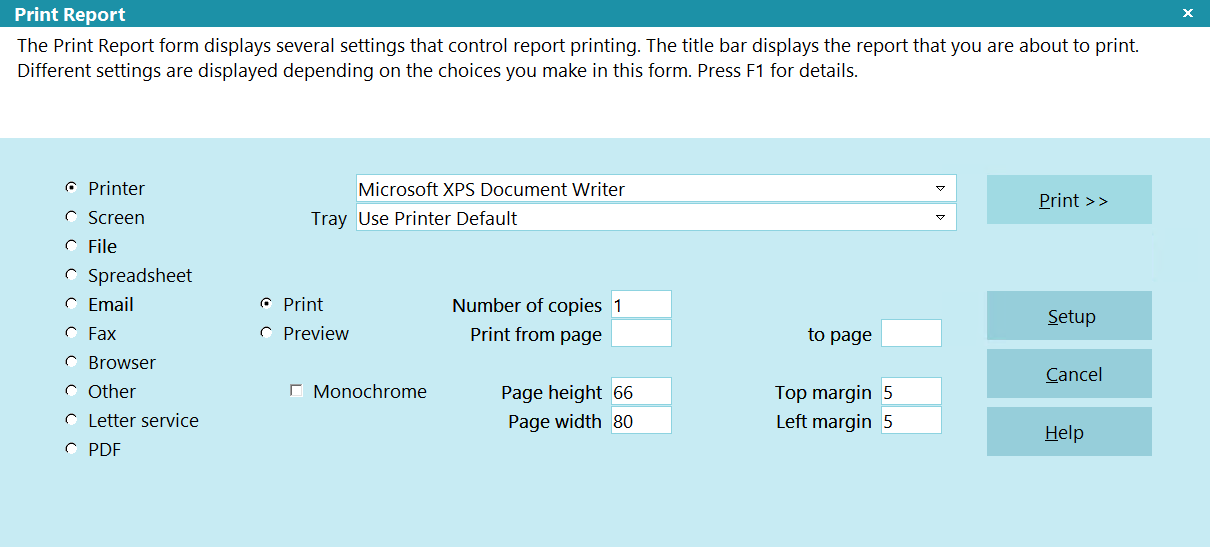
Print Report Screen
Clicking the Print>> button will execute your request as per your selections in this window.

Report Destinations
PRINTER
Typically you send reports to a printer. You can select from the list of printers installed on
your PC.
Printer
This field displays the default printer. It may contain a pick list that you can select from.
Tray
If your printer supports printing to different trays, you can select a tray in this field. This is
used with the @TRAY command in the report writer.
Print
This selection prints directly to the printer.
Preview
This selection opens a Print Preview so that you can preview your letter or report before sending
it to the printer.
SCREEN
You can send the report to the Screen. This allows you to quickly review the report. Control codes
embedded in the document will display in this view. Use Preview instead if you wish to see a
representative example of what the output will look like when you send it to the printer.
This option is useful when you are executing a process that requires a real-time run in order to
complete contact events but where you do not wish to generate actual paper output. Preview does not
mimic an actual execution and thus will not mark contacts done where such is the objective.
FILE
Outputs to a file in the format you specify, with the name you select and writes to the path
destination of your choice. File extensions should be .html, .txt or .csv. After clicking the radio
button beside File, click the Browse button to navigate to your file output destination and give
the report a name and file extension type.
SPREADSHEET
Choose this option to output a csv file to a spreadsheet which you can open with your preferred
program (i.e. Excel, Open Office, UltraEdit, Notepad). Your file name and destination are selected in
the same manner as with File above, by clicking Browse. Use file name extension .csv so that you are
able to open it in your program of choice.
EMAIL
Choose this option to print the report as an Email. The report will automatically be sent through
your Email program to the address in the Debtor's or Client's Email field.
 Emailing through Collect! requires configuration prior to usage. See your Systems
Administrator to find out if your office has been set up for email usage.
Emailing through Collect! requires configuration prior to usage. See your Systems
Administrator to find out if your office has been set up for email usage.
FAX
Choose this option to print the report as a Fax. The report will automatically be sent through your
Fax modem to the phone number you choose in the Fax # field.
BROWSER
This selection will print the report to an html document which can be previewed and/or printed from
your default web browser.
OTHER
Choose this option to print the report to an alternate word processor, such as WordPad or Word.

Other Print Options
Other print options allow you to specify page size and margins, and also which pages of the report
you want to print.
Number of Copies
Enter the number of copies you want to print. It is pre-filled with the default 1 copy. No change
is required if this is your selection.
Print From Page
This setting specifies the starting page number of the report. If the report is 20 pages long and
you want to start printing on the 10th page, enter 10 in this field. This field is blank by default.
To Page
This specifies the ending page number of the report. If the report is 20 pages long and you only
want to print the first 5 pages, type 5 in this field. This field is blank by default.
Page Height
The page height lets you specify the number of lines that will be printed on each page before the
form feed function advances to the next page. It is defaulted to the correct number for a standard,
portrait orientation page output.
Page Width
This will determine where printed lines wrap automatically. This is especially important for the
Quick Print option. 66 is a standard width. It is defaulted to the correct number for a standard,
portrait orientation page output.
Top Margin
This specifies the number of blank lines printed at the top of each page. It is blank by default.
Most letters/reports contain individual document format codes as part of the source they are written
with. It is not necessary to place an entry in this field.
Left Margin
This specifies the number of spaces left blank on the left side of each page. Most letters/reports
contain individual document format codes as part of the source they are written with. It is not
necessary to place an entry in this field.

Canceling A Report
You can back out of the print process by selecting the Cancel button on the Print Report pop-up or
by pressing any key if the print job is in progress.
The program will pause and ask if the report should be cancelled.
YES - Stops printing the report.
NO - Continues printing the report.
MAILING LABELS
Mailing labels can be printed for debtors and clients. Before printing your daily reports, you will
be asked to choose to print either the letters or mailing labels. Please be sure you have the
appropriate paper in the printer. If you have a separate printer for labels, you will be able to
select that printer before the printing begins.
 Order of operations is to print Mailing Labels before batch letters so that your obtain your
labels before the process of the actual letters completes the letter contact event.
Order of operations is to print Mailing Labels before batch letters so that your obtain your
labels before the process of the actual letters completes the letter contact event.
You can modify the label format by using the Print menu, Customize Printing, Edit Report Templates
option. For Debtor labels, the report is named Debtor Mailing Label. For the
clients, the report is named Client Mailing Label.

User's Guide - Working Accounts
This user's guide is an orientation to familiarize all Operator types with Collect! basics.

Starting Collect!
Once you have launched Collect!, you will see the splash screen below.

Collect! Splash Screen
Enter your login credentials in the ID and Password fields indicated.
IDs display as block capital letter entries irrespective of how you input the ID. Passwords are case
sensitive. If you get an 'invalid' message, check your cap-locks and retry. Depending on your site's
preferences, your password may be all lowercase, uppercase or a mixture of cases. Your entry must
match exactly.
When you have entered your login credentials, you will be advanced to the Welcome screen.

Welcome To Collect!
Click START to enter the program.
Your Operator Type and User Level will determine what screen you are presented with next.
Administration/Data Entry/Management see a Main Menu screen while collection personnel are navigated
directed to their WIP windows.

Main Menu
The choices in the Main Menu are described in the User's Guide - Administration.

Work In Progress
For collection personnel, the WIP screen provides all-points access necessary to work their accounts.

Daily Collection Activities
As your WIP list is generating, it will be gathering all accounts which have a scheduled, In Progress
contact associated with your Operator ID which is dated for the current day PLUS anything which you
had in Priors (dated prior to current but not yet worked).

Work In Progress To Do List

Entering The To Do List
The list displays contacts scheduled to be worked today. It is called your " To Do List." What you
see in your list depends on how your office as configured your WIP settings. Typically, it is
contact event types Review, Phone, Promise and Other which are used to build a collector WIP list.
The following describes the significance of the screen features and options available to you.
TO DO LIST COLUMNS
Collect! ships with default list views, meaning the columns being shown and order they appear in are
general. A highly popular feature in the software is the ability to customize your list views to
present you with the information that is most relevant to you and restructure the column order to
meet your own preferences.
By right-clicking your mouse on the column header row, you will be presented with the options of
adding or removing columns from your view. You can also click into the label of a column to expand
or narrow the width to suit your view as well as drag-and-drop the column to a different position
in the column order.
The same capability to modify list views exists for most browse lists in the system.
Any columned list in Collect! which shows you it has a triangle on the right end of column label
is an indicator that you may sort that column in ascending or descending order by clicking your
mouse on that triangle.
In the upper portion of the WIP screen, you will see a series of radio buttons and drop-down pick
list menu options. These are your Filtering options. By making selections within these pick lists,
your WIP will regenerate, showing only those accounts which meet the selected criteria.
For collections personnel, these sub-WIP tools allow for strategic working of accounts. For
administration and management, these tools provide easy access to desk counts and inventory breakdown
data for operations monitoring and metrics.
Type is the kind of contact event that you have scheduled; Phone, Promise, Review,
or Other.
Priority is a value from 1 to 99 that indicates how urgent you designated this
contact event to be. It may be used to further sub-WIP your accounts within the same Type. For
example, a Priority 99 can be used to alert you to handle this right away, while a 20 may indicate
non-prime-time hour attention.
Debtor is the name of the debtor whose account the contact refers to.
Status is the Status on the debtor's account.
Description is what you have typed into this line when the contact event was
created. Collectors can use this as their 'next step' note to themselves to negate redundant note
line review each time an account is scheduled to be worked. Events scheduled by automated processes
will have a generic description which is associated with the Contact Plan that was used to insert
the event. For example, your office may have " New Business - Work Account" in the description line
of Review contacts created when new listings are entered. Phone events do not permit free-form
description entry; they require selection from a pick list of which phone you plan to dial on your
next contact.
Date is the scheduled work date.
Time may be used to time queue an account. Use this feature to meet a specific
request for call-back, night calls and when you are endeavoring to adhere to attempts at different
times of day standards in your work plans. It is important to NOT time queue every account on your
desk. This may cause non-timed accounts to be left unworked due to the over-queuing of timed calls.
Client is the Client Number for the debtor's account.
Owing is the Balance on the debtor's account.
Timezone tells you which of the timezones that debtor account is located in on the
basis of area code on the phone number(s). Use Sort in this column to assist you in making the most
efficient use of legal calling hours. For example, if you are located in a Pacific timezone, you can
start Eastern night calls by sorting your timezone column for Eastern accounts anytime after 3pm in
your local timezone.

Debtor Screen Basics
Viewing Account Information
The Debtor screen contains all known information about the debtor since it was received by your
office. The upper portion of the screen contains the tombstone details and demographic contact
information known about the account. The upper right corner identifies which client this debtor
owes. Below the client information and client account number, you will see the financial summary
information down the right side of the screen. This shows you to-date totals of what is owing in
any of principal, interest, costs and also a total of what has been paid to-date, if applicable.
The Tabs running horizontally in the lower part of the screen are separate sub-folders associated
with the account. When a tab is gray in color, there is nothing in it. When it is yellow, see this
as the 'light is on' and something is in there to be viewed.
Any tab which opens with 2 small square buttons in the upper right corner of the tab display is a
window which may be expanded to full screen size by clicking on the square. The tab contents will
return to regular size when you click the square a second time. You may exit the tab view by
clicking the "x" to close it or by pressing your Esc key.
In addition to the Tabs, there is further information on the account which may be viewed by clicking
into fields of selecting from the bank of buttons in the lower right corner of the screen, beneath
the OK button.
Any screen you enter may be exited by clicking an associated "x" in the corner of the pop-up window
or by pressing your Esc key. In other views, you may be prompted to acknowledge a pop-up by clicking
an OK button or clicking on a choice for Yes (or No).
Actions you can take on a debtor screen include review all existing information, add notes, add
payment plan, post a payment, establish your next work date by adding a new contact event, update
address information (depending on your User permissions), update status, send a letter, send an
internal request to a coworker or manager via contact event, or run a contact plan to invoke one or
more events.
Navigation around the screen is via your mouse point/click or if you prefer keyboarding, you can
use your Tab key to migrate from field to field on the screen.
A complete set of notes on the debtor may be viewed by selecting the Notes tab on the Debtor screen.
Click into the Notes area. In addition to the tab window expansion, if you are presented with a
scroll bar on the right of the tab display, then there is additional information which you can't
currently see because it doesn't fit in the regular/contracted tab display size. Use the scroll bar
to page down through additional information if you do not wish to expand the tab display to full screen.

Typing Debtor Notes
Unlimited notes may be entered either free-hand by clicking into the Note tab body area, you will be
presented with a pre-filled date/time/user ID stamp and a flashing cursor waiting for you entry. It
is also possible to enter notes via action/result contact plans which your office may set up to
eliminate redundant note line entry. For example, a Contact Plan action/result code could be defined
to do all of auto-write a note line such as "Tel Res - NA" for you as well as update your account
status code from NEW to ACT once it has been worked.
Viewing Payment History
Select the Transactions tab to view a list of individual payments made as well as any charges levied
on this account. Click into the Transactions area and scroll down to view the entire list of line
entries, or, expand the window to full screen by clicking the square in the right corner.
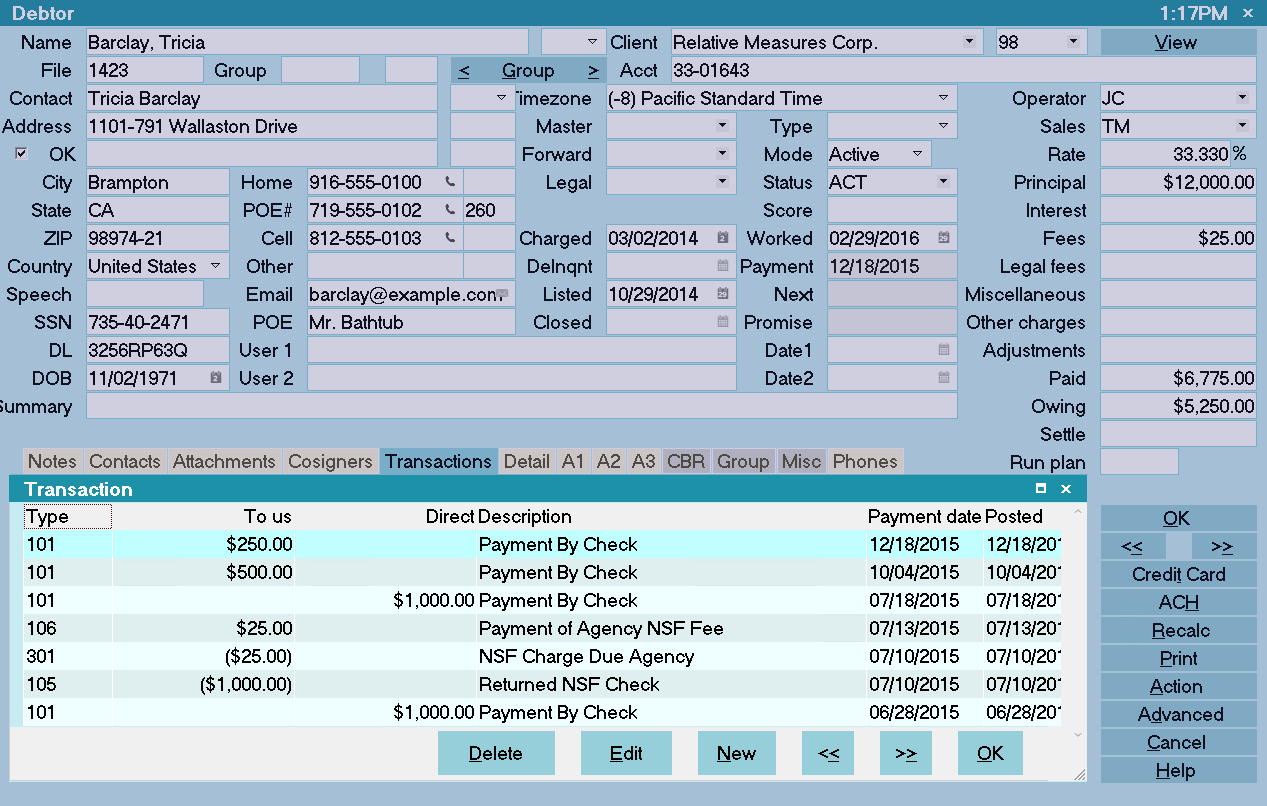
Debtor Payment History
Summary payment information may be displayed by clicking into the Owing field on the main debtor
screen to obtain the Debtor Financial Summary pop-up. This window shows you totals for original
amount(s), paid amount(s), accrued amount(s) for interest/other costs or charges, arriving at the
balance owed and displaying this with a breakout into the balance component parts.
Viewing Additional Account Information
Additional information pertaining to the account is stored in the Detail, Attachments, Cosigners,
Credit Bureau, and Group tabs.
Select the Detail tab to enter bank account information.

Debtor Detail
Select the Cosigner tab to enter either additional responsible parties on the debt AND use this
feature to store associated information such as employer, attorney, references, next of kin, spouse
(not responsible), alternate or previous address details, and alias names. Utilizing the window
Class and Type descriptors allows you to set up as many windows as you need for each account to
store relevant data.
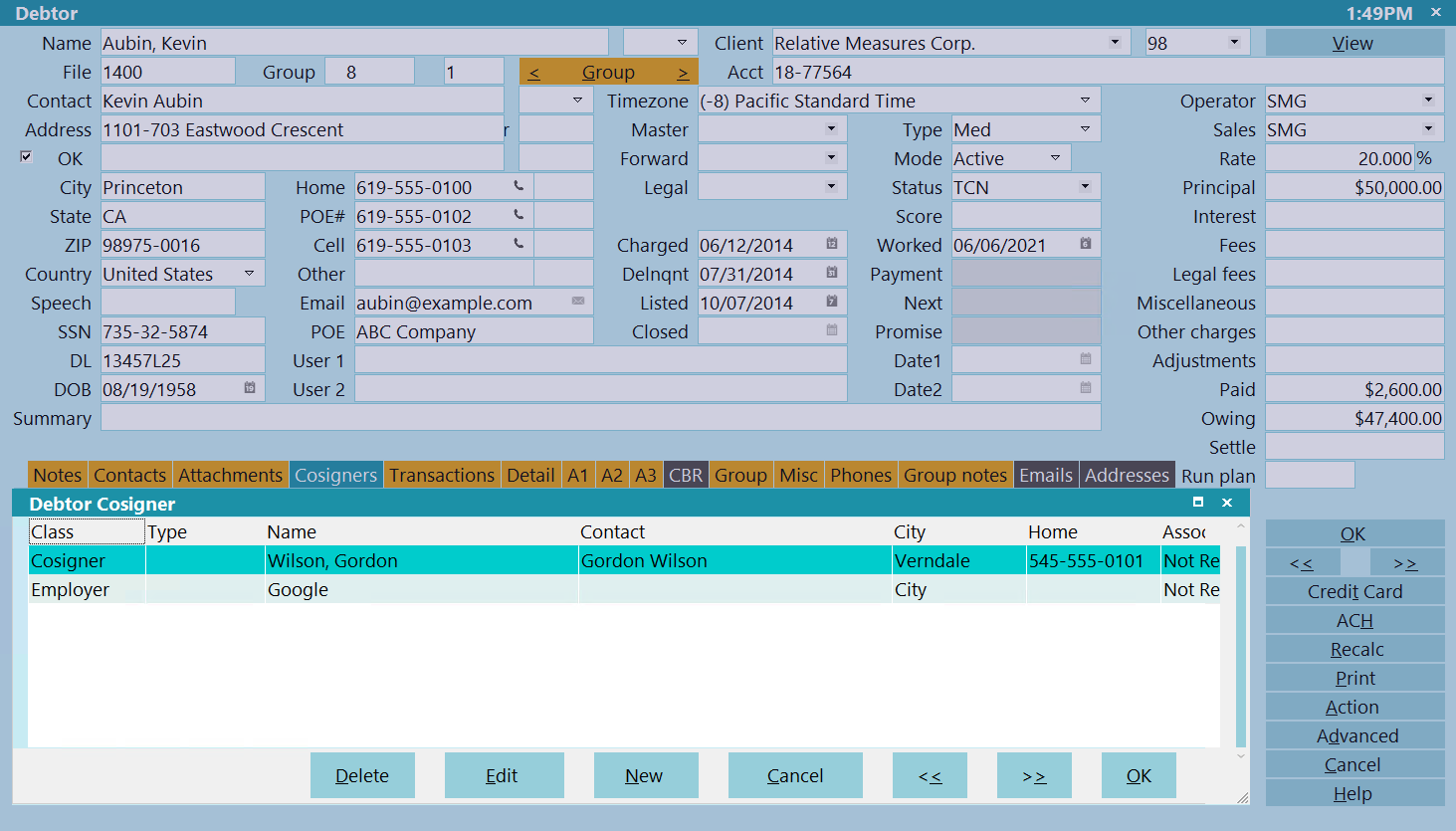
Debtor Cosigners
Viewing Contact History
Select the Contacts tab to view a list of all contacts for this debtor. Within this tab you will
see the full complement of events which have taken place on this account including letters sent,
how many updates have been sent to the Credit Bureau (if applicable) as well as all collector and
manager events completed.
If you need to see the contents of any letter sent, highlight the letter event of interest and click
on it to open. In the line labeled "Attachment", you will see the word [METAFILE]. This means there
is an image of the letter and what it contained exactly as it was sent on the indicated date that
the contact event was completed.
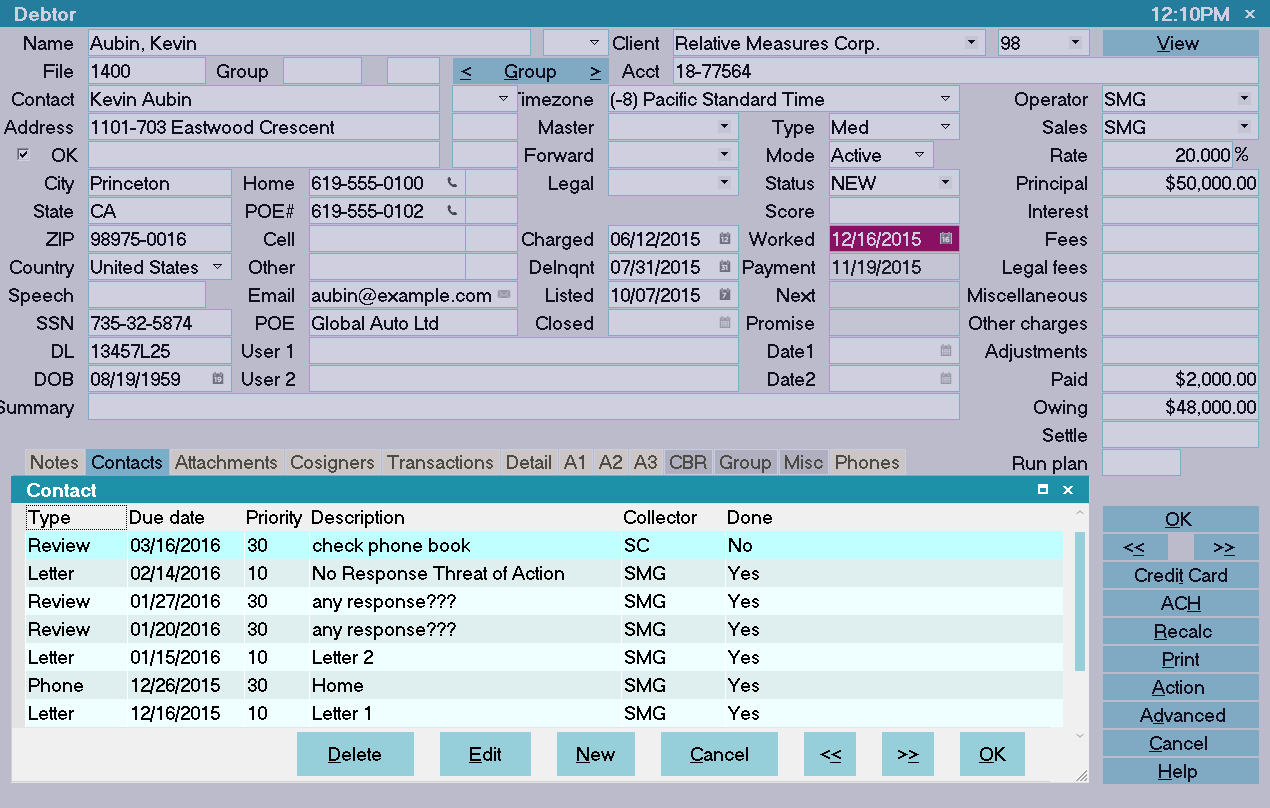
Contact Schedule
From a WIP list, you will select a contact event to work and click on it to open the file.

WIP Scheduled Debtor Account
The yellow bar beneath the "Summary" field displays information from the contact event you selected
from your WIP list. The reason for this is two-fold; (a) it saves keystrokes in that you do not
need to stop to open your Contact tab and (b) it identifies exactly which contact item you selected
in the event that you have more than one scheduled contact with the same work date on the same
debtor account.
When you have completed all the work you wish to do on this account today and are ready to advance
to the next account in your queue, you need to do 2 things before advancing. Each site will make
an individual decision as to how they want contact events to be managed; voluntarily or by automatic
prompt. Please see your management to find out which process you should follow:
If your office is using WIP Option "Always show next contact when" switch checked On:
- After selecting and working your WIP account, click the right pointing arrow key (under the OK
button) to advance to the next account. You will receive 2 pop-ups. The first will ask you to
choose between marking the current contact event done, leaving it in your WIP or staying on the
account. If you are done, proceed to step 2.
- Click the Mark it Done button.
- You will immediately be presented with the second pop-up which will be the item you need to
setup your next work date by assigning a new contact event with a new date to be worked.
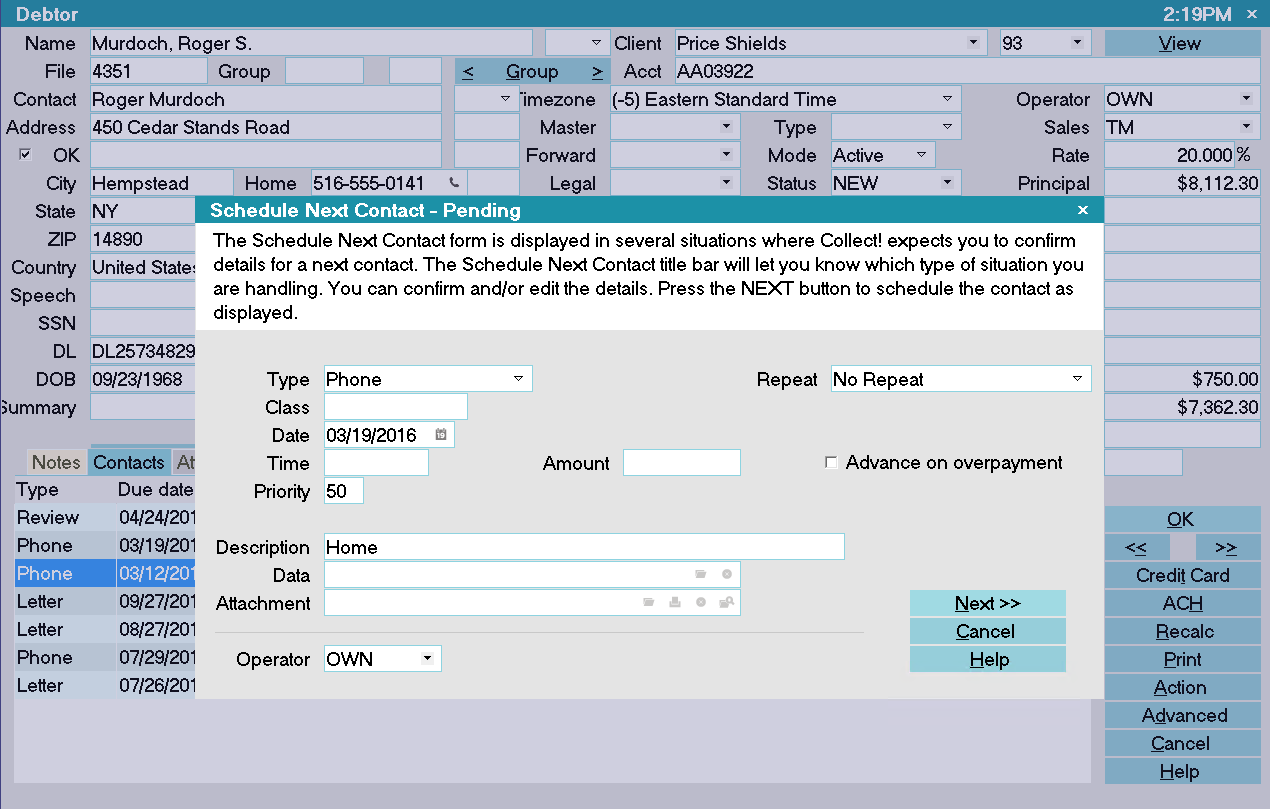
Schedule the Next Contact
If your office has not using the "Always show next contact when" feature:
- Click into the Contacts Tab, and then click the New button or F3 to generate a fresh event window
to set your next work date. Choose the contact Type and Date for your next event and enter your
'next step' Description, if applicable.
- Click the double arrow button pointing right under the OK button on the main debtor screen. You
will receive another pop-up.
- Choose whether to Mark it Done, Leave it in WIP list or Stay on Account. If you are ready to
advance to the next file, and you do not need to return to this account for any reason today,
choose Mark it Done. If you need to return to it today, click Leave it in WIP list. You will
then be advanced to the next account or back to your WIP list itself.
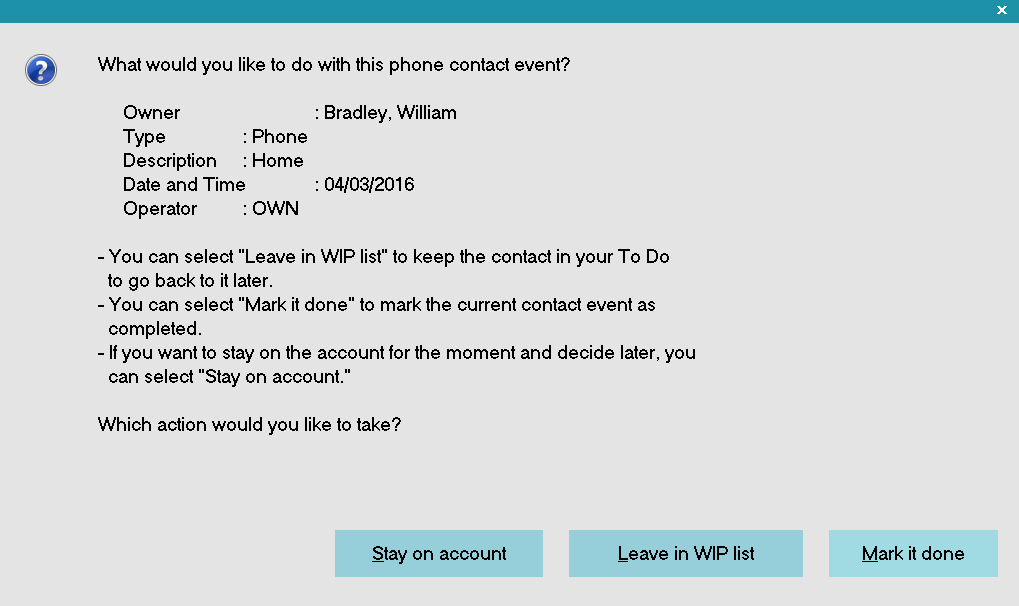
Prompt to Complete the Contact
- Click the double arrow pointing right to advance to the next account in your WIP list.

Schedule the Next Contact
It is necessary to enter a next work date contact event. Accounts which do not have an In Progress
contact scheduled no longer appear in a WIP list and become an 'orphaned' account. Orphaned accounts
can be located and sent back to the current collector's WIP or an alternate operator's ID by running
an internal inventory management report that will insert a current dated Review event with a
Description of Forgotten.
 We recommend that each site run the Orphaned Account Search report weekly. It is located in
the menu path "Tools\Utilities".
We recommend that each site run the Orphaned Account Search report weekly. It is located in
the menu path "Tools\Utilities".

Letters On Demand
While administration/clerical departments will be looking after scheduled letters to be printed,
collectors may have occasions where outputting a letter must be created/printed immediately.
Printing a single letter on a specific account right away is accomplished in these easy steps:
- The account to receive the letter needs to be on your screen.
- Depending on personal preference and user level, there are two ways to access the Print menu:
- by clicking the Print button in the lower right hand corner where the OK button is located, or
- by clicking the drop-down menu Print from the top of the screen and selecting the option
Reports and Letters.
A list of available letters/reports is displayed.
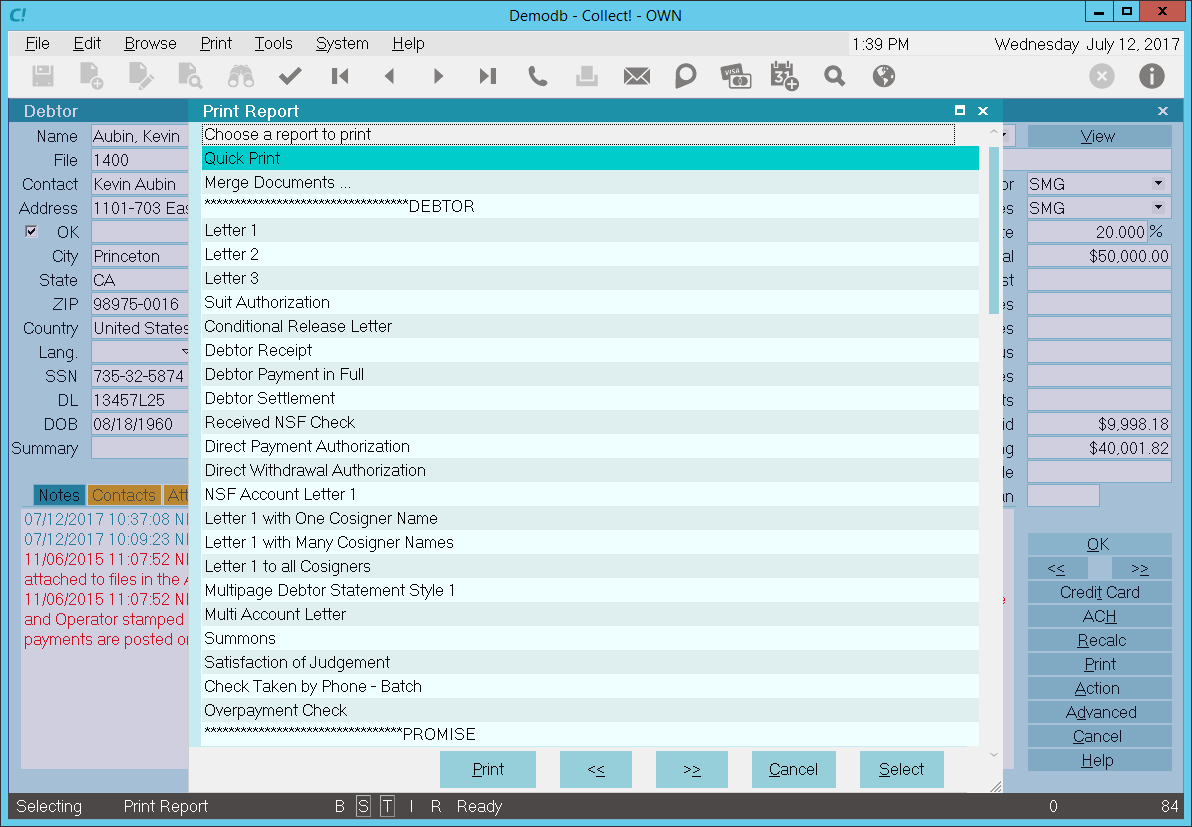
Printing a Letter Immediately
- Select the letter you want to print and either click on it or press the Enter key. You will get
a pop-up to launch the print task.

Print Window
The configured default printer name will appear as the device your letter is going to be sent to.
To select a different network printer, click the drop-down arrow at the end of the field displaying
the printer name an select which device you wish to have the print job sent to.
- Click the button labeled Print and your letter will be sent to the chosen printer to be produced.
 If you have opened the Print Menu and can't see any of the debtor letters you expect to see,
then you are likely in one of the associated account Tabs and not really on the main debtor
file. The solution is to exit the Print Menu, click into the background in the upper portion
of the debtor account display to re-establish your location in the system and retry clicking
Print. This time you should see debtor related reports/letters in the menu listing.
If you have opened the Print Menu and can't see any of the debtor letters you expect to see,
then you are likely in one of the associated account Tabs and not really on the main debtor
file. The solution is to exit the Print Menu, click into the background in the upper portion
of the debtor account display to re-establish your location in the system and retry clicking
Print. This time you should see debtor related reports/letters in the menu listing.
All reports and letters have a designation of where in the system they may be initiated from. For
example:
Anywhere - a report which may be run from any part of the system.
Debtor - must be run from a debtor list or an individual debtor file.
Client - must be run from a client list or an individual client.

| 
Was this page helpful? Do you have any comments on this document? Can we make it better? If so how may we improve this page.
Please click this link to send us your comments: helpinfo@collect.org